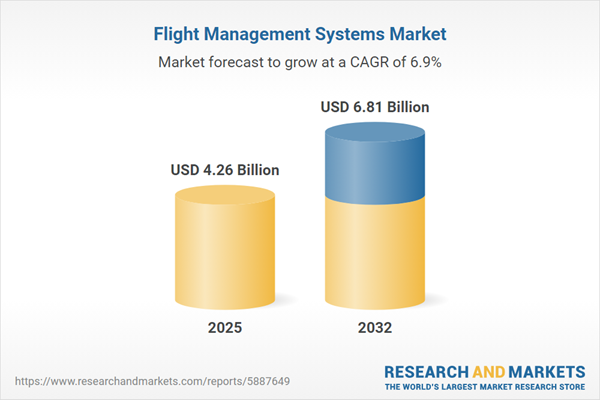Speak directly to the analyst to clarify any post sales queries you may have.
Flight management systems are driving pivotal changes for aviation executives seeking operational precision, regulatory adherence, and digital transformation. Leadership teams now regard FMS integration as key to future-proofing fleet performance in an environment of evolving compliance and mission requirements.
Market Snapshot: Flight Management Systems Market Size and Growth
The global flight management systems market is experiencing significant momentum, with a valuation of USD 3.98 billion in 2024. This is projected to rise to USD 4.26 billion in 2025 and continue an upward trajectory, reaching USD 6.81 billion by 2032. The compound annual growth rate, calculated at 6.94%, showcases the persistent demand for modernization. These market dynamics are shaped by a sector-wide push toward automated workflows, real-time analytics, and digital capabilities, as both commercial and defense operators reinforce reliability and compliance. With regulatory frameworks growing more demanding and operational scenarios diversifying, organizations are making strategic investments in FMS as a driver of resilience, adaptability, and technological alignment for long-term competitiveness.
Scope & Segmentation: Areas of Flight Management Systems Adoption
- Platform Type: Adoption spans business jets, commercial aircraft, regional planes, military fleets, helicopters, and unmanned aerial vehicles. Each platform requires tailored solutions addressing factors such as mission flexibility, regulatory compliance, or extended operational endurance.
- Component: Next-generation systems feature high-integrity processors, customizable cockpit displays, global navigation hardware, adaptable mission management software, and services for upgrades and maintenance. Together, these components enable resilient and future-ready operations.
- Application: Common uses of FMS include precise navigation, dynamic flight planning, real-time monitoring, and safety management. These applications support both routine operations and critical missions where accuracy and continuity are essential.
- End Use: Organizations benefit from FMS through both new equipment installations and retrofitting of legacy fleets, maximizing asset life while integrating advanced functionalities efficiently.
- Regional Coverage: Mature aviation markets focus on automation and compliance enhancements, whereas emerging regions drive foundational safety improvements and infrastructure scaling to address rapid sector growth and new traffic sources.
This broad segmentation assists executives in prioritizing investment, aligning modernization efforts with operational and regional risk, and establishing partnerships attuned to both local demands and global standards. The ability to address diverse needs across fleet types and geographies further aids in managing risk as industry regulations and deployment environments continue to evolve.
Key Takeaways: Strategic Insights for FMS Market Leadership
- Modular architectures in FMS allow responsive adaptation to evolving compliance standards and mission demands, ensuring ongoing readiness across varied operational scenarios.
- Artificial intelligence and predictive analytics streamline maintenance processes, boosting system availability and reducing the frequency of unexpected disruptions caused by unplanned downtime.
- Advancements in satellite navigation and integrated communications technologies provide efficient routing and stable connectivity, crucial for effective operations in congested and remote environments.
- Robust cybersecurity is essential to safeguard digital cockpit environments and maintain trust among regulators, operators, and industry partners.
- Dedicated collaboration among suppliers, integrators, and regulatory authorities underpins consistent system performance and compatibility across mixed fleet environments.
- Continuous, balanced technology updates alongside thoughtful retrofitting of established platforms support modernization while extending value and service life of critical assets.
Tariff Impact: Addressing Cost Pressures and Supply Chain Resilience
With new U.S. tariffs anticipated for 2025, flight management systems providers are proactively reevaluating sourcing and logistics models. Implementing regionalized manufacturing and diversifying supplier networks have become strategic measures, especially in the procurement of processors and cockpit displays. These adjustments aim to build robust supply chain resilience, allow avoidance of project delays, and protect profit margins amid shifting regulatory or geopolitical factors. Maintaining trust and stability for customers throughout these market fluctuations hinges on safeguarding supply chain integrity and efficient delivery performance.
Methodology & Data Sources
This report is based on executive-level interviews, rigorous analysis of flight management system architecture, and thorough reviews of key regulatory, financial, and intellectual property domains. Independent validation ensures that findings presented are actionable and reliable for strategic decision-making.
Why This Report Matters
- Assists senior executives and procurement specialists in coordinating FMS strategies that align with shifting mission objectives, operational needs, and compliance requirements.
- Provides frameworks for adopting new technologies and managing risk in a complex and evolving global regulatory context, supporting robust operational planning.
- Supports investment decisions aimed at enhancing resilience and enabling scalable growth in today’s competitive aviation sector.
Conclusion
Applying the insights from this report enables aviation leaders to refine FMS strategies and reinforce operational reliability. With strengthened positioning, organizations are prepared to navigate changes and advance performance in a dynamic market environment.
Additional Product Information:
- Purchase of this report includes 1 year online access with quarterly updates.
- This report can be updated on request. Please contact our Customer Experience team using the Ask a Question widget on our website.
Table of Contents
3. Executive Summary
4. Market Overview
7. Cumulative Impact of Artificial Intelligence 2025
Companies Mentioned
The companies profiled in this Flight Management Systems market report include:- Honeywell International Inc.
- Raytheon Technologies Corporation
- Thales S.A.
- General Electric Company
- BAE Systems plc
- L3Harris Technologies, Inc.
- Safran S.A.
- Northrop Grumman Corporation
- Garmin Ltd.
- Universal Avionics Systems Corporation
Table Information
| Report Attribute | Details |
|---|---|
| No. of Pages | 186 |
| Published | October 2025 |
| Forecast Period | 2025 - 2032 |
| Estimated Market Value ( USD | $ 4.26 Billion |
| Forecasted Market Value ( USD | $ 6.81 Billion |
| Compound Annual Growth Rate | 6.9% |
| Regions Covered | Global |
| No. of Companies Mentioned | 11 |









